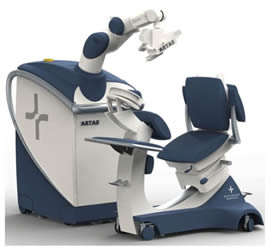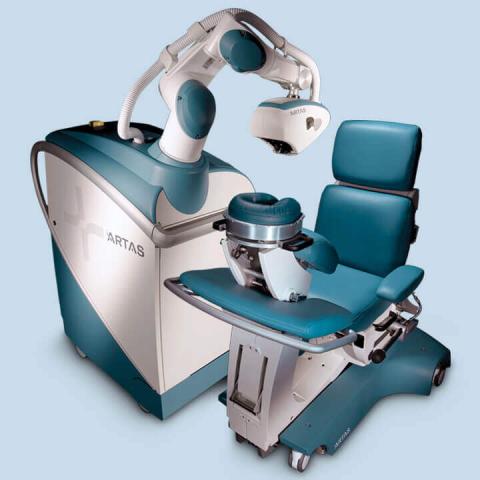
In response to the rising popularity of robotic assisted follicular unit excision (formerly know as follicular unit extraction) (FUE), in 2011 Restoration Robotics announced the release of the ARTAS Hair Restoration System – an FDA cleared device for automating the extraction process during FUE hair transplantation. Although many remained skeptical at first, several highly respected hair transplant surgeonsrecommended on the Hair Transplant Networkrecognized its potential after researching the machine and have incorporated it into their every day hair transplant practice. To learn more about the ARTAS and physicians who have adopted its use, visit the Hair Loss Q&A Blog article "ARTAS Hair Restoration System and the Hair Transplant Surgeons Who Use It"
The ARTAS' recent rise in popularity leads to several important questions. What is the ARTAS system and how does it work? What advantages does it offer over other extraction devices? What are leading hair restoration physicians saying about the device? Should the ARTAS be used by new and inexperienced hair transplant surgeons and/or medical assistants?
What is the ARTAS Hair Restoration System and How Does it Work?
Unlike other motorized devices, the ARTAS system relies heavily on a computer-based program to automate the FUE process. After attaching a digital imaging device to the universal donor region of a patient’s scalp, the ARTAS utilizes a software program to “map” the donor area and relay the image to a larger screen. Using a patented algorithm, the ARTAS then identifies each follicular unit in the donor region and determines its individual orientation, direction, angle, distribution pattern, and position in the overall scalp.
For a live demonstration of the ARTAS in action, view the below video clip featuring Coalition member DR. Robert Bernstein.
The device then pin-points the exact location of each follicular unit, compensates in real-time for natural patient movement, and prepares each graft for harvesting. A robotic arm then deploys a 1mm needle (containing both “sharp” and “dull” components), extracts the graft, and prepares the unit for forceps removal by a technician. After removal of a particular follicular unit, the ARTAS rescans the donor region and utilizes a randomization pattern to select the next graft.
According to the manufacturers, the ARTAS technology cuts transection rates to a reasonable 8%, and allows physicians to treat patients with an “unprecedented level of precision, efficacy, and safety.”
Advantages and Disadvantages of the ARTAS Compared to Other Devices
Because the true success of any FUE hair transplant procedure lies within the hands of the operating surgeon, it’s hard to compare one device to another. However, when objectively comparing the features of the ARTAS to the features of other devices, it appears as if the system does offer a variety of superior assets.
Advantages
First, unlike other motorized FUE extraction devices, the ARTAS seems to avoid some of the common extraction pitfalls that frequently decrease graft quality which can diminish overall hair growth yield. Because the device removes grafts with less tension and torsion, cuts to a depth of 4 mm, and leaves a “pad” of sustainable fat around the extracted grafts, the follicular units undergo a minimal amount of trauma and provide adequate yield. What’s more, because the device doesn’t utilize any sort of vacuum or suction mechanism to remove the grafts before implantation, the grafts aren’t exposed to excessive drying.
The ARTAS offers quick but precise extractions that allows hair transplant physicians to remove an average of 900 to 1200 follicular units per hour with minimal transection rates as low as 8%. Because the extraction software determines the correct orientation, angle and direction of each follicular unit and uses an algorithm to randomly select grafts; the ARTAS is highly accurate and avoids harvesting too much donor hair from any particular area. Thus, the risks of both transection and visible scarring are dramatically reduced. The ARTAS also decreases the risks of human error, fatigue and mishandling of the grafts - all of which can lead to damage to the follicles and poor growth.
Future versions of the ARTAS may also assist with transplanting follicular units into balding areas.
Disadvantages
The ARTAS also possesses several disadvantages. Currently, the ARTAS system is only available with a 1mm punch extraction tool (needle), which is larger than the typical .7mm to .9mm punches used by many leading FUE hair transplant surgeons. Using larger punches can increase the risk of visible scarring and may reduce the quantity of available donor hair. Furthermore, the ARTAS is expensive (estimated at approximately $80,000) and may drive up the costs for patients considering FUE robotic hair transplant Surgery.
Unlike the NeoGraft Hair Transplant Machinethat's been marketed to neophyte surgeons and untrained medical professionals, the ARTAS is marketed to experienced hair transplant doctors. However, the highly automated nature of the device may lead inexperienced physicians and technicians into performing FUE using the ARTAS with substandard results. Furthermore, the ARTAS has not been cleared by the FDA for female patients, patients with light hair and individuals with curly hair. Thus, individuals who don't fit into this niche of potential candidates may suffer from higher transection rates and lower yields.
Because the skin tensor/mapping camera is large and requires patients to remain prone (face down), patients may experience some additional discomfort during a follicular unit excision procedure via the ARTAS.
What Are Leading Hair Restoration Physicians Saying About the Device?
In order to discover exactly what leading physicians are saying about the ARTAS, we went straight to the source and asked the six expert physicians recommended on the Hair Transplant Network who regularly utilize the ARTAS system in their follicular unit excision procedures today.
According to Coalition physician Dr. Jerry Cooley, the ARTAS is a well planned, useful device that capitalizes on number of trusted FUE techniques and keeps the needs of patients and hair restoration physicians in mind. For a more comprehensive discussion and review of Dr. Cooley’s reply, view the article "Dr. Jerry Cooley Acquires and Provides Input on the ARTAS Hair Restoration System for Automating FUE Hair Transplantation".

Recommended physician Dr. James Harris feels similarly and believes the device is highly accurate in assessing the follicular unit configuration, angles and directions. He also believes the system is reliable and easy to learn, and flexible enough to allow the physician ultimate control over the extraction process. To read Dr. Harris’ full reply, view the article "Dr. James Harris Shares His Experience with the ARTAS Follicular Unit Extraction System". For a comprehensive interview and question and answer session with Dr. Harris, visit "Dr. Harris Answers Critical Questions about the ARTAS".
Coalition physician and FUE pioneer Dr. Bernstein believes the ARTAS system eliminates some of the elements of human error and fatigue associated with the FUE process, and recognizes that the blades used by the device meet the quality standards set by other trusted FUE devices. However, he does believe the device has room for improvement and is working with Restoration Robotics to make these upgrades. To read more about Dr. Bernstein's opinion of the ARTAS, visit "Advantages of the ARTAS Robotic Assisted Hair Transplant for Follicular Unit Extraction (FUE)".
Should “Neophyte” Hair Transplant Surgeons Use the Device?
One of the biggest concerns with the advent of automated FUE devices is the potential for untrained or inexperienced surgeons and/or technicians using these devices. As these machines become more advanced and independent, inexperienced or untrained physicians or technicians may become tempted to purchase and profit from the ARTAS system. However, many experts, including Dr. Jerry Cooley believe this is dangerous. Below, Dr. Cooley explains the problems with neophyte surgeons and/or untrained technicians using the ARTAS device:
This has me very concerned. My experience with the ARTAS system has been overwhelmingly positive, but I cannot imagine trying to operate the device without all my years of FUE experience. Furthermore, even if the neophyte were able to extract high quality grafts consistently, that represents only the graft harvesting part of the entire hair restoration treatment plan. This plan spans everything from the consultation where graft needs are assessed, medications are prescribed, realistic expectations are set to the aesthetics of hairline design/graft distribution and site creation/graft implantation.
Acquiring an automated FUE device does not make one an expert in all these areas. And delegating these to technicians who do not have a license to practice medicine raises serious legal and ethical issues. Ultimately, the ARTAS is a device, and nothing more. It is the physician and his or her staff that will determine the success of the procedure and whether the patient is satisfied with the outcome.
Conclusion
Altogether, the ARTAS FUE system appears to represent a “step in the right direction” with regard to robotic-assisted follicular unit excision. Restoration Robotics consulted with some excellent hair transplant surgeons while designing the device and created a useful product that is well liked by a large number of experienced hair restoration physicians . What’s more, the device seems to respect the wants and needs of FUE procedures and excels where other, comparable products have failed.
Altogether, it seems as if the ARTAS device is a useful FUE tool, and one that could offer positive results to patients when utilized by trained, dedicated hair transplant surgeons.











